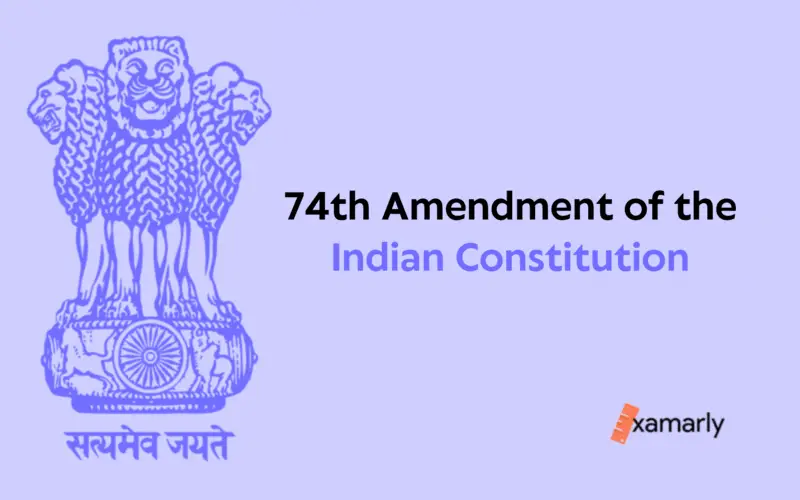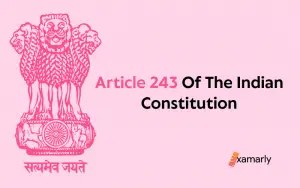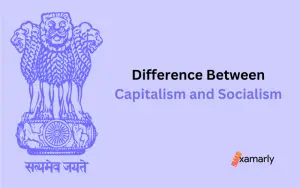The Seventy-Fourth Amendment Act of the Indian Constitution of 1992 dealt with the devolution of power into the systems of Municipalities or Urban Local Governments.
It specifically catered to bringing down power to the grassroots level. In other words, this amendment dealt with municipalities or urban local government units.
As a result, it provided a constitutional framework for urban local self-government groups.
In this article, we will discuss the historical background, objectives, and features of the 74th Amendment of the Indian Constitution.
This article will take you through how the 74th amendment sets a framework for the decentralization of duties and obligations to basic units at the grass root level.
This is an important topic for UPSC Exams. So, read on to learn this amendment thoroughly.
Why Urban Bodies?
Urban bodies provide a substantial contribution to the country’s economic growth. If this development is to be maintained people and their representatives must be fully involved in the formulation and execution of programs at the local level.
That is, if democracy is to stay strong, its roots must reach towns, villages, and cities where people live.
The Indian Constitution has extensive measures for safeguarding democracy’s protection in Parliament and state legislatures.
As a result, democracy has persisted and thrived in these institutions. However, the Constitution does not make local self-government in cities an explicit constitutional need.
Democracy in municipal government was unstable as a result of an insufficient Constitutional framework for Local Self Government.
As a result, many metropolitan municipal governments were weak democratic units that couldn’t function efficiently.
The reduced standing of urban local governments galvanized public sentiment in favour of the need for a constitutional guarantee to protect the interests of urban local governments.
Evolution of Urban Bodies
Now, you read about the need for proper development of urban administrative bodies in the last section.
Before we go into the constitutional amendment that dealt with aspects of the urban administrative bodies, let us look at how these evolved historically from the British regime to now.
- 1687-1688 – First Indian municipal corporation specified at Madras
- 1726 – Municipal corporations founded in other places like Calcutta and Mumbai
- 1870 – Lord Mayo’s Financial Decentralisation Resolution
- 1882 – Lord Ripon passed the “Magna Carta” of municipal self-government.
- 1907-1909 – In 1907, Royal Commission on Decentralization was constituted and additional reports were issued in 1909.
- 1919 – The Government of India Act made local self-government a transferred subject
- 1924 – The Cantonments Act was approved
- 1935 – Local self-government was specified as a provincial subject.
74th Amendment of the Indian Constitution
The 74th Amendment of the Indian constitution decentralized powers and functions to municipal organizations at various levels of administration.
It provided statutory provisions for urban administrative bodies that are towns and cities. Constitutionally, it amended article 280 and inserted Part 9A and Schedule 12.
Let us brush through the official details of the constitutional status of this amendment. The 74th CAA was brought into motion on 1 June 1993.
The Joint Parliamentary Committee’s report was brought up for discussion and passed by the Lok Sabha and the Rajya Sabha on December 1992. and it obtained the President’s assent on April 20, 1993.
The “Constitution (Seventy-Fourth Amendment) Act, 1992” was published in the Government Gazette on April 20, 1993. The Constitution (Seventy-Fourth Amendment) Act, 1992 added a new section to the Constitution, Part IXA, which deals with municipal concerns.
Objectives of the 74th Constitutional Amendment
Problem
The Statement of Objectives and Reasons begins with an identification of the problem or lack at hand. Local governments in many states have grown weak and ineffectual for a number of reasons.
This means that they are affected by the inability to hold regular elections, protracted supersession, and insufficient devolution of authorities and services.
Thus, urban local governments are unable to function as vibrant democratic self-government entities.
Possible Areas of Improvement
After the assessment of the problem, the amendment goes on to identify the possible areas of improvement:
- Improving the association between the State Government and the Urban Local Bodies in terms of functions, taxation, and revenue sharing understandings
- Conduction of regular election conduct
- Esurance of timely elections in cases of supersession
- Providing adequate representation for the weaker sections such as Scheduled Castes, Scheduled Tribes, and women
The New Pact
The new pact catered to various areas of urban administration, a few of which will be discussed in detail under the section titled features. In brief, it deals with:
- Establishment of three different sorts of municipalities
- Municipalities must have characteristics that will be established by the state legislature
- Choosing a municipality’s chairperson must be in accordance with state legislation
- Creation of Committees at the ward level or at any other level or levels within a Municipality’s geographic boundaries as permitted by State legislation
- Seat reservations in each Municipality
- A set five-year term for the Municipality, followed by a six-month period for reelection. Elections must be held within six months following a municipality’s dissolution if it occurs before the end of its term
- Delegation of authority by the State Legislature to the Municipalities to prepare plans for social justice and economic development and to implement any necessary development plans to allow them to operate as institutions of self-government;
- Imposition of taxes and duties by municipalities, the assignment of those taxes and obligations to municipalities by state governments along with the State’s provision of grants-in-aid to municipalities as specified by state law
- A Finance Commission to examine the municipal finances and provide recommendations
- The Comptroller and Auditor-General of India audits the financial records of Municipal Corporations and presents findings to the state legislature and the Municipal Corporation
- A state legislature passed legislation mandating that municipal elections be run under the supervision, guidance, and control of the state’s top electoral officer
- Applying Bill’s provisions to any Union territory or portion of it with any changes the President may specify
- The Bill’s applicability is limited to the Scheduled Regions listed in Article 244’s first sentence and the tribal areas mentioned in its second clause.
- Disqualification from participation in a municipality
- Restriction on the court’s ability to hear cases involving municipal elections
Link of Relatable Articles:
| Tricks To Remember Amendments Of the Indian Constitution |
| 7th Amendment Of the Indian Constitution |
| 42nd Amendment Of the Indian Constitution |
| 21st Amendment Of the Indian Constitution |
Constitutional Provision
How are these objectives proposed as constitutional amendments? Let us find the provisions with respect to articles inserted or amended.
Insertion of 9A
Part 9A is inserted after Part 9. Articles 243-P to 243-ZG were added as a part of it. These Articles include the addition of these concepts:
- Article 243P – Definitions of words like the committee, metropolitan area, municipal area, municipality, panchayat
- Article 243Q – Division of Municipalities into 3 categories namely Municipal Council, Nagar Panchayat, and Municipal Corporation
- Article 243R – Composition of municipalities into wards
- Article 243S – Structure and composition of Ward Committees
- Article 243T – Seat reservations
- Article 243U – Municipality duration
- Article 243V – Ineligibility for membership
- Article 243W – Municipalities’ powers, authorities, and duties
- Article 243X – Municipalities’ ability to levy taxes and manage municipal funds
- Article 243Y – Financial Commission
- Article 243Z – Municipalities’ accounts audit
- Article 243ZA – Election for Municipalities
- Article 243ZB – Application for Union territories
- Article 243ZC – Parts not applied for certain areas
- Article 243ZD – The planning committee for the district
- Article 243ZE – Metropolitan planning committee
- Article 243ZF – Maintaining current laws and municipal structures.
- Article 243ZG – Preventing judges from meddling in electoral processes
Insertion of Schedule 12
Schedule 12 brought in salient features of:
- Town planning, which includes urban planning.
- Land usage and building construction are regulated.
- Making plans for social and economic growth.
- Bridges and roads.
- Water supply for residential, commercial, and industrial uses.
- Solid waste management, sanitation conservation, and public health.
- Fire protection.
- Urban forestry, environmental preservation, and ecological awareness
- Protecting the rights of society’s weakest groups, such as the physically and intellectually challenged.
- Upgrades and improvements to slum areas.
- Urban poverty alleviation
- Presence of areas like gardens, playgrounds, or parks for the urban settlement
- Promotion of aesthetic aspects, ecological aspects, educational awareness, and cultural elements
- Burial grounds or cremation grounds and facilities
- Cattle pens; animal cruelty prevention
- Vital statistics such as registration of birth and death.
- Infrastructure built for the benefit of the public, including parking spaces, bus stations, and streetlights.
- Control over tanneries and slaughterhouses.
Amendment of Article 280
74th Amendment of the Indian Constitution amended article 280. As a modification to Article 280 by the law matters, the sub-clause referring to the measures necessary to augment the Consolidated Fund of a State shall be inserted before sub-clause (d) as so re-lettered in clause (3) of article 280 of the Constitution.
This subclause states that the measures required to boost the Consolidated Fund of a State in order to supplement the Municipalities’ resources within the State are in accordance with the recommendations given by the State’s Finance Commission.
Significance
- The expansion of a country’s towns and cities has a considerable impact on the rate at which the economy of that country expands.
- As the rural hinterland develops, these metropolitan centres provide a crucial support system.
- To sustain this economic development in response to local needs and circumstances, it is essential that people and their representatives take an active role in the design and implementation of local initiatives.
- If democracy is to remain robust and resilient not only in Parliament but also in State Legislatures, it must have deep roots in the communities where people really live. This is because locals will be among the most impacted by any changes made to these areas.
Features of the 74th Amendment Act 1992
Let us look at the features of the 74th Amendment of the Indian Constitution guarantee in detail.
Constitution of Municipalities
The 74th Constitutional Amendment Act creates three distinct classifications of municipalities, including urban municipalities. This categorization of municipalities is based on size and land area as opposed to population. They are as follows:
- Municipal Corporations – A larger and more populous urban area
- Municipal Councils – A smaller urban area
- Nagar Panchayat- A region undergoing a rural-to-urban transformation
Composition of Municipalities
The 74th Amendment of the Indian Constitution provides for the composition of municipal bodies. Here, direct elections will be employed to fill the seats.
This means that all members of the local body must be directly elected by the citizens of the municipality. Each Municipality is divided into territorial constituencies known as wards.
It’s possible that the legislature of the state has some say in who gets to be the chairwoman of a municipality.
The given individuals may also be represented by it in a municipality:
- Individuals without the ability to vote at municipal meetings but who have specific expertise and experience in administration.
- Members of the Lok Sabha and state legislatures who represent districts that completely or partially overlap the municipal territory.
- Members of the Council of States and the State Legislative Council registered to vote in the municipality.
- Chairpersons of committees excluding those of ward committees
Constitution of Wards Committee
Section 243S of the Act mandates the constitution of ward committees in urban areas with a population of three lakhs or more.
The purpose of the wards committee is to ensure citizen participation in decision-making processes and to bring the government and citizens closer together.
Each ward in a municipality shall have a wards committee. These ward committees are responsible for addressing local problems and participating in the planning, administrative, and financial functions of the municipality.
Committee for District Planning
A District Planning Committee must be established in every state at the district level. The Committee for District Planning is a constitutional institution. It is responsible for preparing district-level development plans.
These community development programs are based on factors such as people’s needs, the capacity of a particular area for growth, and the available budgetary resources.
This enables better investment decisions tailored to district needs. In addition, district planning plays a crucial role in social and economic justice planning.
One of the key tasks of the DPC is to consolidate rural and urban plans, which is vital in light of problems associated with urban expansion into rural areas.
Further, it helps to coordinate the plans created by the district’s panchayat and municipalities and to compile a district-wide development plan.
In drafting the Draft Development Plan, the District Planning Committee shall take into account the following factors:
- Matters of common interest to the Panchayats and Municipalities, including spatial planning
- Sharing of water and other physical and natural resources
- Integrated development of infrastructure and environment conservation
- Amount and type of resources, whether financial or otherwise, that are currently available.
Metropolitan Planning Committees
For the purpose of creating a draught development plan for the metropolitan region as a whole, a Committee for Metropolitan Planning must be established in every metropolitan area (with a population of 10 lakhs or more).
The 74th Constitutional Amendment Act of India has set up Metropolitan Planning Committees in several cities across the country.
These committees are composed of elected members of municipal and panchayat bodies, which are responsible for preparing a draft development plan for the metro area.
The MPC is also responsible for reviewing and revising local plans and providing a forum for resolving conflicts.
The following will be taken into consideration by the Metropolitan Planning Committee while creating the Draft Development Plan:
- Sharing of water and other physical and natural resources
- Integrated development of infrastructure and environmental conservation
- Overall objectives and priorities set by the Government of India and the State Government
- Extent and nature of investments likely to be made
- Matters of common interest between the Municipalities and Panchayats
- Resources whether financial or otherwise
City and State Governments Will Stay the Same
The 74th Amendment of the Indian Constitution brought forth some clarity regarding the continuance of existing laws and municipalities.
All state legislation dealing with municipalities will remain in effect until the end of the year following the passage of this act.
If not disbanded by state legislatures, all municipalities that existed before the enactment of this law can resume existing until the end of their tenure.
Limitation on Judicial Oversight of Elections
The Bar to Interference by Courts in electoral matters is a provision of the 74th Amendment Act of India, which prevents courts from interfering with the conduct of elections.
While the Constitution allows the legislatures and SECs to make rules governing elections, it specifically prohibits courts from interfering with elections.
It states that no court may rule against the legality of any statute governing the creation of constituencies or the distribution of seats among them.
Additionally, it states that no municipal election may be challenged except if a proper procedural petition is submitted to the authorized body.
Reservation of Seats
The Act requires provisions for the reservation of seats for the scheduled castes and scheduled tribes in every municipality.
This is to be calculated based on their number relative to the total population of the municipal territory.
Additionally, it stipulates that at least one-third of the available seats must be designated for women (including the number of seats reserved for women belonging to the SCs and the STs)The state legislature may specify how to reserve chairs in municipalities for women, minorities, and people of colour.
It may also include any clauses for allotment of seats or chair positions in any municipality for members of underprivileged classes.
Duration of Municipalities
According to the Act, Municipalities have a five-year tenure. In case they are dissolved before the end of the tenure, elections to the new municipal body must be held within six months.
Elections to form a municipality are necessary to be conducted before the municipality’s term expires.
Functions and Authorities of Local Governments
All municipalities would be given the authority and responsibility necessary to function as successful institutions of self-government.
The State Legislature may, by law, specify the responsibilities of municipalities with regard to creating plans for social justice and economic growth and carrying out programs delegated to them.
Finances of Municipalities
It has been left to a state’s legislature to establish by law things pertaining to taxation and government finances.
Municipalities derive their revenue primarily from two sources: tax revenue and non-tax revenue.
Due to rapid urbanization, however, there is an increasing possibility of revenue shortfalls, making municipalities reliant on grants, devolution of resources from the central government, and borrowing from financial institutions. This legislation specifies the finance activities as:
- Taxes, duties, fees, and so on that municipalities may levy and collect in accordance with the method outlined in state law.
- Taxes, duties, fees, and so on that would be imposed and collected by the State Government, with a portion distributed to municipalities.
- State grant-in-aid to municipalities
- The facility of funds for the crediting and withdrawal of cash by municipalities
Finance Commission
The Finance Commission was formulated by Article 243-I. It is responsible for reviewing the financial state of Panchayati Raj as well as the Municipalities.
The Finance Commission examines the financial circumstances of municipalities and offers recommendations to the Governor.
The Finance Commission’s proposals and its list of functions will include the following:
- Division of amount amongst State governments and municipalities of what has been received through state-levied taxes, duties, tolls, and fees
- Allocation of a portion of such earnings to municipalities
- Municipality’s allocation and collection of duties, taxes, tolls, and fees.
- Grants-in-aid from the State Consolidated Fund
Elections to Municipalities
The State Election Commissions must be in charge of supervising, directing, and controlling the production of electoral rolls for, and the conduct of, all elections to panchayats and municipalities.
Audit and Accounts
The maintenance of municipal accounts and auditing of municipalities should be carried out in compliance with the norms of State legislation. State legislatures will be allowed to establish suitable legislation in this respect based on local requirements and the institutional structure available.
Types of Urban Governments
For the purpose of managing urban regions, India has established the eight types of urban local bodies listed below:
- Special Purpose Agency
- Port Trust
- Township
- Cantonment Board
- Town Area Committee
- Notified Area Committee
- Municipality
- Municipal corporation
Municipal Personnel
In India, there are three different kinds of municipal personnel systems. The employees of urban administrations may fall under one of the three categories, or all three. These are:
- Unified Personnel System
- Separate Personnel System
- Integrated Personnel System
Municipal Revenue
Urban local governments draw their income from five different sources. These are listed below:
- Loans
- Tax Revenue
- Devolution
- Non-Tax Revenue
- Grants
Conclusion
The Seventy-Fourth Amendment Act of India was passed in 1993. The 74th amendment of the Indian constitution is related to the decentralization of powers.
It was intended to herald a fundamental change in India’s governance of democratic bodies and its institutional framework.
The 74th Amendment of the Indian Constitution is an important piece of legislation, which provides states with broad rules on city governments.
This Act has strengthened the role of urban local bodies and given them decision-making powers.
It includes features that will ensure regular elections, decentralization of tax collection agencies, and regular functions for small communities.
To know more about other Amendments of the Indian Constitution log on to Examarly.
FAQs on the 74th Amendment of the Indian Constitution
What is a local government?
A local government is a form of government that is responsible for governing a specific geographic area, such as a city, town, or county.
What is a municipal corporation?
A municipal corporation is a legal entity that is created by a state government to manage and govern a city or town.
What is the role of local government?
The role of a local government is to provide basic services to its residents, including public safety, sanitation, transportation, and infrastructure development.
How are local governments funded?
Local governments are funded through a variety of sources, including property taxes, sales taxes, and fees for services such as garbage collection and water and sewer services.
How are local government officials elected?
Local government officials are typically elected by the residents of the area they serve. The specific method of the election varies depending on the location, but common methods include at-large elections, district elections, and nonpartisan elections.






